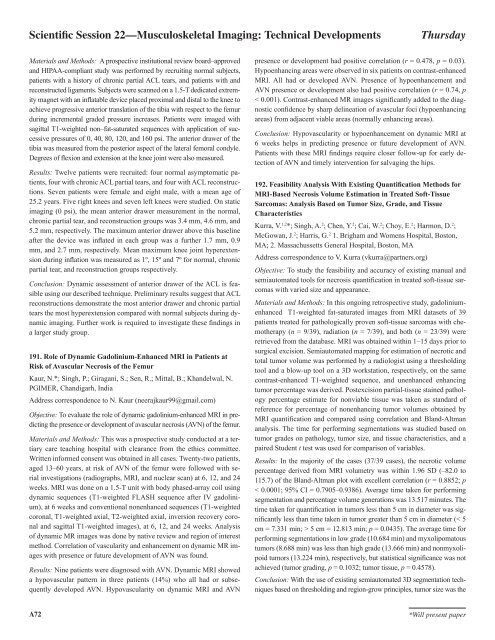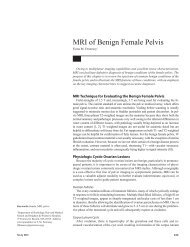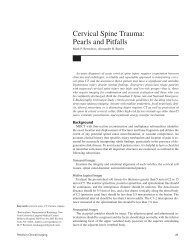Scientific Session 1 â Breast Imaging: Mammography
Scientific Session 1 â Breast Imaging: Mammography
Scientific Session 1 â Breast Imaging: Mammography
Create successful ePaper yourself
Turn your PDF publications into a flip-book with our unique Google optimized e-Paper software.
<strong>Scientific</strong> <strong>Session</strong> 22—Musculoskeletal <strong>Imaging</strong>: Technical DevelopmentsThursdayMaterials and Methods: A prospective institutional review board–approvedand HIPAA-compliant study was performed by recruiting normal subjects,patients with a history of chronic partial ACL tears, and patients with andreconstructed ligaments. Subjects were scanned on a 1.5-T dedicated extremitymagnet with an inflatable device placed proximal and distal to the knee toachieve progressive anterior translation of the tibia with respect to the femurduring incremental graded pressure increases. Patients were imaged withsagittal T1-weighted non–fat-saturated sequences with application of successivepressures of 0, 40, 80, 120, and 160 psi. The anterior drawer of thetibia was measured from the posterior aspect of the lateral femoral condyle.Degrees of flexion and extension at the knee joint were also measured.Results: Twelve patients were recruited: four normal asymptomatic patients,four with chronic ACL partial tears, and four with ACL reconstructions.Seven patients were female and eight male, with a mean age of25.2 years. Five right knees and seven left knees were studied. On staticimaging (0 psi), the mean anterior drawer measurement in the normal,chronic partial tear, and reconstruction groups was 3.4 mm, 4.6 mm, and5.2 mm, respectively. The maximum anterior drawer above this baselineafter the device was inflated in each group was a further 1.7 mm, 0.9mm, and 2.7 mm, respectively. Mean maximum knee joint hyperextensionduring inflation was measured as 1º, 15º and 7º for normal, chronicpartial tear, and reconstruction groups respectively.Conclusion: Dynamic assessment of anterior drawer of the ACL is feasibleusing our described technique. Preliminary results suggest that ACLreconstructions demonstrate the most anterior drawer and chronic partialtears the most hyperextension compared with normal subjects during dynamicimaging. Further work is required to investigate these findings ina larger study group.191. Role of Dynamic Gadolinium-Enhanced MRI in Patients atRisk of Avascular Necrosis of the FemurKaur, N.*; Singh, P.; Giragani, S.; Sen, R.; Mittal, B.; Khandelwal, N.PGIMER, Chandigarh, IndiaAddress correspondence to N. Kaur (neerajkaur99@gmail.com)Objective: To evaluate the role of dynamic gadolinium-enhanced MRI in predictingthe presence or development of avascular necrosis (AVN) of the femur.Materials and Methods: This was a prospective study conducted at a tertiarycare teaching hospital with clearance from the ethics committee.Written informed consent was obtained in all cases. Twenty-two patients,aged 13–60 years, at risk of AVN of the femur were followed with serialinvestigations (radiographs, MRI, and nuclear scan) at 6, 12, and 24weeks. MRI was done on a 1.5-T unit with body phased-array coil usingdynamic sequences (T1-weighted FLASH sequence after IV gadolinium),at 6 weeks and conventional nonenhanced sequences (T1-weightedcoronal, T1-weighted axial, T2-weighted axial, inversion recovery coronaland sagittal T1-weighted images), at 6, 12, and 24 weeks. Analysisof dynamic MR images was done by native review and region of interestmethod. Correlation of vascularity and enhancement on dynamic MR imageswith presence or future development of AVN was found.Results: Nine patients were diagnosed with AVN. Dynamic MRI showeda hypovascular pattern in three patients (14%) who all had or subsequentlydeveloped AVN. Hypovascularity on dynamic MRI and AVNpresence or development had positive correlation (r = 0.478, p = 0.03).Hypoenhancing areas were observed in six patients on contrast-enhancedMRI. All had or developed AVN. Presence of hypoenhancement andAVN presence or development also had positive correlation (r = 0.74, p< 0.001). Contrast-enhanced MR images significantly added to the diagnosticconfidence by sharp delineation of avascular foci (hypoenhancingareas) from adjacent viable areas (normally enhancing areas).Conclusion: Hypovascularity or hypoenhancement on dynamic MRI at6 weeks helps in predicting presence or future development of AVN.Patients with these MRI findings require closer follow-up for early detectionof AVN and timely intervention for salvaging the hips.192. Feasibility Analysis With Existing Quantification Methods forMRI-Based Necrosis Volume Estimation in Treated Soft-TissueSarcomas: Analysis Based on Tumor Size, Grade, and TissueCharacteristicsKurra, V. 1,2 *; Singh, A. 2 ; Chen, Y. 2 ; Cai, W. 2 ; Choy, E. 2 ; Harmon, D. 2 ;McGowan, J. 2 ; Harris, G. 2 1. Brigham and Womens Hospital, Boston,MA; 2. Massachussetts General Hospital, Boston, MAAddress correspondence to V. Kurra (vkurra@partners.org)Objective: To study the feasibility and accuracy of existing manual andsemiautomated tools for necrosis quantification in treated soft-tissue sarcomaswith varied size and appearance.Materials and Methods: In this ongoing retrospective study, gadoliniumenhancedT1-weighted fat-saturated images from MRI datasets of 39patients treated for pathologically proven soft-tissue sarcomas with chemotherapy(n = 9/39), radiation (n = 7/39), and both (n = 23/39) wereretrieved from the database. MRI was obtained within 1–15 days prior tosurgical excision. Semiautomated mapping for estimation of necrotic andtotal tumor volume was performed by a radiologist using a thresholdingtool and a blow-up tool on a 3D workstation, respectively, on the samecontrast-enhanced T1-weighted sequence, and unenhanced enhancingtumor percentage was derived. Postexcision partial-tissue stained pathologypercentage estimate for nonviable tissue was taken as standard ofreference for percentage of nonenhancing tumor volumes obtained byMRI quantification and compared using correlation and Bland-Altmananalysis. The time for performing segmentations was studied based ontumor grades on pathology, tumor size, and tissue characteristics, and apaired Student t test was used for comparison of variables.Results: In the majority of the cases (37/39 cases), the necrotic volumepercentage derived from MRI volumetry was within 1.96 SD (–82.0 to115.7) of the Bland-Altman plot with excellent correlation (r = 0.8852; p< 0.0001; 95% CI = 0.7905–0.9386). Average time taken for performingsegmentation and percentage volume generations was 13.517 minutes. Thetime taken for quantification in tumors less than 5 cm in diameter was significantlyless than time taken in tumor greater than 5 cm in diameter (< 5cm = 7.331 min; > 5 cm = 12.813 min; p = 0.0435). The average time forperforming segmentations in low grade (10.684 min) and myxolipomatoustumors (8.688 min) was less than high grade (13.666 min) and nonmyxolipoidtumors (13.224 min), respectively, but statistical significance was notachieved (tumor grading, p = 0.1032; tumor tissue, p = 0.4578).Conclusion: With the use of existing semiautomated 3D segmentation techniquesbased on thresholding and region-grow principles, tumor size was theA72*Will present paper
















